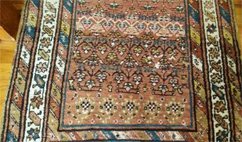ABRASH COLORATION
in
RUGS

What is Abrash Coloration in Rugs?
Abrash coloration in rugs (pronounced ‘uh-brash’) is the differing color patterns, colorations, and various shades or hues within a rug. It is one of the most common and typical characteristics of a genuine oriental rug, and especially among older or 'nomadic' handmade rugs.
Authentic oriental rugs, by their very nature, have many variations because they are hand-made rather than machine-made and the yarn is hand-spun. This hand-made manufacture results in certain distinct and unique characteristics that set real oriental rugs apart from lesser reproductions.
With true abrash coloration, gradations can often be seen within one color or color field in the design, such as the blues, reds, browns or other colors. These variations may appear as bands or horizontal bars, but other shapes or sections of color variation are possible. Abrash coloration can vary from subtle shade differences to distinct or even bold variations in certain colors of the rug.
Modern machine-made replications of oriental rugs often attempt to imitate the natural abrash found in oriental rugs.
What Causes Abrash Coloration in Rugs?
Abrash coloration can result from:
- Differences in the dyeing process such as a different dye
lot and the strength of the dye. Since all-natural dyes are not chemically or synthetically based or fixed, no two dye lots can ever be the same.
- Natural aging in old and antique rugs.
- An intentional creative effect or personal expression of the weaver.
- Sun-fading.
- Chemical treatments such as 'tea-washing.' (An attempt to make a rug look softer and older.)
Abrash in a Rug May be Revealed
After a
Thorough Cleaning
Sometimes the abrash color variation in rugs is covered over or obscured by soiling and compaction of the rug pile with use and wear. When the rug is cleaned, surface soiling is removed and the pile is groomed and made more erect. The truer and authentic pile coloration is now revealed, along with some abrash color variations that were there at the time of manufacture.
In addition, there is a possibility that slight variations in pile direction or 'shading' will also be seen after a thorough cleaning. One or both of these effects show up as color variations in the rug.
These distinct colorations are not defects at all but are characteristic of the many variables and dye lot differences that went into the original hand-made rug.
Abrash vs. Sun Fading in Rugs
Abrash coloration in rugs can sometimes be confused with color fading from the sun. There are 2 ways to determine whether a rug has a naturally occurring abrash or whether it has been damaged by sun fading.
Look closely at the back of the rug in the same area as on the opposite side.
If you see no signs of color variation, then it is likely sun fading, since the effects of sun fading would not go through to the back of the rug.
Please note: In some oriental rugs or even within some areas of an oriental rug, it is possible that the dye may not have penetrated all the way through to the back of the rug to the foundation, usually cotton, upon which the wool is woven and knotted.
Look into the pile by spreading it apart.
If the color is stronger toward the middle or lower area of the wool, this would likely be due to sun fading. If the color is fairly uniform throughout the pile, it is very likely the rug is exhibiting abrash.
Please note: Rugs can be chemically treated or 'tea-washed' to give them a softer appearance and the look of an antique rug. The 'tea-washing' can fade over time or be partially removed during cleaning resulting in color variations that may look similar to abrash.
Abrash—Imperfection or Unique Work of Art?
Because beauty is ultimately in the eye of the beholder, the characteristic of abrash coloration in rugs may be construed as either an 'imperfection' or as an example of the unique beauty of a hand-made work of art.
Connoisseurs of antique and semi-antique oriental rugs value the beauty and hand-made appearance that is typical of abrash. Rug collectors often look for warm or creative abrash in oriental rugs.
Some of the highest quality rug manufacturers spend a lot of time and money simulating this abrash in their machine-woven rug designs as well. Abrash is part of the beauty and distinctive natural appearance of hand-made oriental rugs, and even of some machine-made synthetic rugs which try to reproduce real abrash.
Before Purchasing an Oriental Rug…
After reading the above information, if you are thinking of purchasing an oriental rug for your home that has possible abrash, you should now be ready to determine if any color variation is part of the weaver's design, a change in dye lots, a naturally occurring process of aging, damage from sun-fading, or the result of chemical washing or tea-washing.
Please note: We would be happy to evaluate any rug for you before purchase. If possible, just bring the rug to our plant in Ithaca or send us a photo of the rug showing both the front and the back to info@abcclean.com. You may also contact us here or call us directly at (607)-272-1566.
Top of Abrash Coloration in Rugs
"The Cleanest Clean You've Ever Seen."
by
ABC Oriental Rug & Carpet Cleaning Co.
130 Cecil Malone Drive Ithaca, NY 14850
607-272-1566

